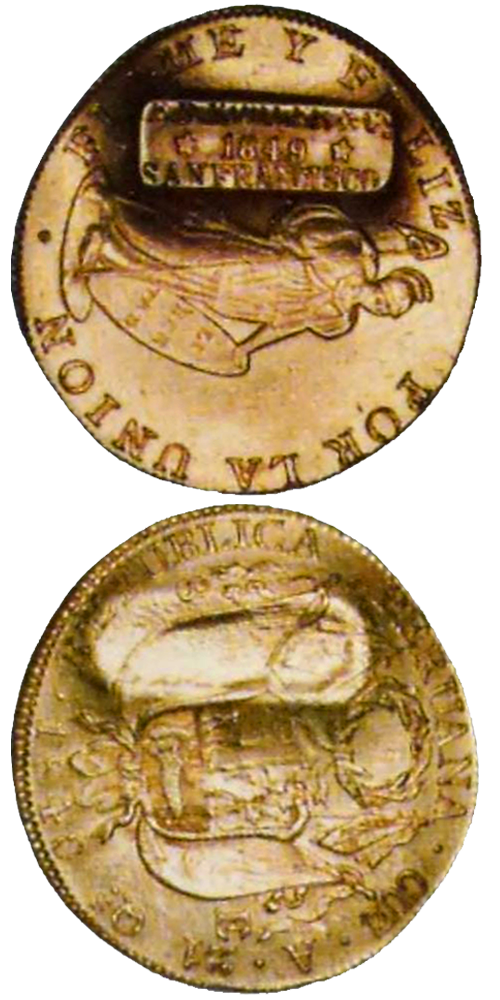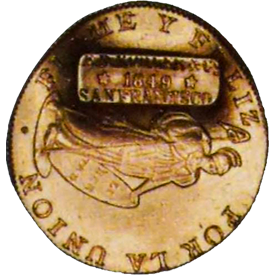Although it was generally considered in the summer of 1848 that gold was worth $18 per ounce, assays of placer metal revealed values of from about $17.90 to $18.20. However, gold was usually accepted in channels of trade for no more than $16 per ounce. Metal which had been extracted by the quicksilver process traded for even less, at $14 per ounce. Many strong objections arose over this practice for it was felt that purchasers of gold at $14 per ounce were simply shipping it to the East and gaining a profit of $4 for each ounce sold in this manner. It was believed that the institution of an official state (territory) assay office of gold would remedy this problem and would allow the precious metal to be exchanged for its true value. On July 22, 1848, the citizens of San Francisco met and petitioned Col. Richard B. Mason, Jr., the military governor of California, to establish an office in this regard. However, nothing came of this appeal.
Other efforts ensued. Finally on April 20, 1859 the Legislature enacted a provision which provided "there shall be established in the city of San Francisco a state office for assaying, melting and refining gold." It was further noted and approved that the governor was to appoint two competent persons to take charge and perform the duties of the establishment, one as director and the other as assayer, melter and refiner of gold.
Each official was required to submit a bond in the amount of $50,000 before assuming his duties. The appointment was to be for the term of one year and until their successors were appointed and qualified. Business was to be transacted daily, except Sunday, from 9 o'clock in the morning until 2 o'clock in the afternoon.
It was further provided that the governor, if petitioned to do so, could establish branch offices in Sacramento, Stockton, or Sonora. Appropriate penalties were provided for members of the public who altered, mutilated, reduced in value, or other-wise tampered with bars or counterfeited them. It was further noted that the office of state assay would be abolished by the governor at such time as an official branch mint of the United States began operation.
It was stipulated that should there be any error in the weight, quality, or value of the gold stamped on the ingots, the assayer and director would forfeit the percentage commissioned, which amounted to 3/4 of one percent of the total amount assayed and issued, and would be personally liable for the difference between the values stamped on the ingots and the true value at the United States Mint's standards.
When the Act was passed, Governor Burnett appointed 0.P. Sutton as director and Frederick D. Kohler as the state assayer. Kohler sold his private assaying business to Baldwin & Co.
Kohler, earlier a jeweler and alderman in New York City, came to California in 1849. In partnership with David C. Broderick, he operated an assaying business in San Francisco.
Both Kohler and Broderick had been firemen in New York. When they reached California they became active in fire protection, with Kohler becoming the first chief engineer and Broderick attending the post of foreman of the Empire Co. Broderick later became a prominent California politician and was elected as a senator.
On May 24, 1850, following the sale of Kohler's private assaying business to Baldwin, Sutton and Kohler ran the following advertisement in the Alta California:
The undersigned have opened an office in the building now occupied by Messrs. Baldwin & Co., south side of Portsmouth Square, and will be prepared to receive gold dust for smelting and assaying on Monday the 13th, in accordance with the provision of the law passed by the Legislature of the State, April 20, 1850. In making this announcement we beg leave to state that desiring to establish an office at the earliest practicable moment our arrangements are necessarily less complete than they otherwise would have been; nevertheless, we trust that they will be found sufficient to meet the needs of the wants of the community.
O.P. Sutton, Director
F.D. Kohler, Assayer
On the first day of operation nearly 5,000 ounces of gold were deposited with the state assayer. In his monumental reference on territorial gold coins, Edgar H. Adams noted that one deposit showing an original weight of 689 1/2 pennyweight, after smelting weighed 682 1/2 pennyweight. The fineness of the lot was 20 3/4 carats, making the value $570.54. On this particular bar the gold dust brokers marked a value of $519. The gold had been bought by them at $14 an ounce. This demonstrates the value of the state assay office.
Apparently each ingot was cast, and then it was dressed by hitting the sides with a hammer. Large bars were apparently subdivided into several smaller ingots. A November 20, 1868 article in the Alta California gave the recollections of a pioneer:
Nineteen years...ago I gazed into the Assay Office of Fred Kohler, situated on the south side of Clay Street, watching for the first time the process of converting gold dust into bars, and the chipping of the bars into $50 ingots. "Slugs" was the name given them. The "bankers," Monte, Faro, and others, [a reference to gambling establishments], being short of coin, and having plenty of dust, had it converted into slugs of that denomination, which they circulated as freely as any other coins, the stamp of the assayer in all cases being taken at its true value. Wass, Molitor & Co., an assayer at San Jose, and others of Mormon vintage, circulated as late as 1852, when they finally disappeared, the octagon slug taking their place...the actual value of Kohler's slug being $52 at the Philadelphia Mint.
The preceding contains a reference to assays performed at the Philadelphia Mint which showed that there was some variation in Kohler's work, and on the average his ingots were worth about 1% to 1 1/2% more than the value stamped on them.
When the United States Assay Office of Gold and Augustus Humbert began operations in San Francisco early in 1851, the state assay office was discontinued. After that time Frederick Kohler conducted his own private assay business.







